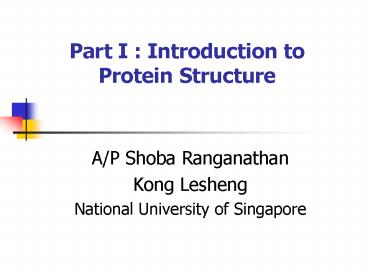Part I : Introduction to Protein Structure - PowerPoint PPT Presentation
1 / 36
Title:
Part I : Introduction to Protein Structure
Description:
Each protein has a particular 3-D structure that determines its function. ... 'The three-dimensional structure of a native protein ... – PowerPoint PPT presentation
Number of Views:63
Avg rating:3.0/5.0
Title: Part I : Introduction to Protein Structure
1
Part I Introduction to Protein Structure
- A/P Shoba Ranganathan
- Kong Lesheng
- National University of Singapore
2
Overview
- Why protein structure?
- The basics of protein
- Levels of protein structure
- Structural classification of protein structure
3
Why protein structure?
- In the factory of living cells, proteins are the
workers, performing a variety of biological
tasks. - Each protein has a particular 3-D structure that
determines its function. - Structure implies function.
- Structure is more conserved than sequence.
- Protein structure is central for understanding
protein functions.
4
To understand functions, we need structures
a- conotoxin ImI and its three mutants
Rogers et al., 2000, JMB 304, 911
5
Anfinsens thermodynamic hypothesis
- The three-dimensional structure of a native
protein - in its normal physiological milieu (solvent, pH,
ionic - strength, presence of other components such as
- metal ions or prosthetic groups, temperature,
etc.) - is the one in which the Gibbs free energy of the
- whole system is lowest that is, that the native
- conformation is determined by the totality of
- interatomic interactions and hence by the amino
- acid sequence, in a given environment.
--- Anfinsens Nobel lecture, 1972
6
What drives protein folding?
- Hydrophobic effects
- Hydrophobic residues tend to be buried inside
- Hydrophilic residues tend to be exposed to
solvent - Hydrogen bonds help to stabilize the structure.
7
Overview
- Why protein structure?
- The basics of protein
- Levels of protein structure
- Structural classification of protein structure
8
The basics of protein
- Proteins have one or more polypeptide chains
- Building blocks 20 amino acids.
- Length range from 10 to 1000 residues.
- Proteins fold into 3-D shape to perform
biological functions.
9
Common structure of Amino Acid
10
Aliphatic residues
11
Aromatic residues
12
Charged residues
13
Polar residues
S
14
The odd couple
Cb
Cg
Side chain H
Cd
Ca
Ca
15
The peptide bonds
16
Coplanar atoms
17
Backbone torsion angles
18
Ramachandran / phi-psi plot
b-sheet
a-helix (left handed)
y
a-helix (right handed)
f
19
Overview
- Why protein structure?
- The basics of protein
- Levels of protein structure
- Structural classification of protein structure
20
Primary structure
- The amino acid sequences of polypeptides chains.
21
Secondary structure
- Local organization of protein backbone ?-helix,
?-strand (which assemble into ?-sheet), turn and
interconnecting loop.
22
Ramachandran / phi-psi plot
b-sheet
a-helix (left handed)
y
a-helix (right handed)
f
23
The ?-helix
- First structure to be predicted (Pauling, Corey,
Branson, 1951) and experimentally solved (Kendrew
et al., 1958) myoglobin - One of the most closely packed arrangement of
residues. - 3.6 residues per turn
- 5.4 Å per turn
24
The ?-sheet
- Backbone almost fully extended, loosely packed
arrangement of residues.
25
Topologies of ?-sheets
26
Tertiary structure
- Packing the secondary structure elements into a
compact spatial unit. - Fold or domain this is the level to which
structure prediction is currently possible.
27
Quaternary structure
- Assembly of homo or heteromeric protein chains.
- Usually the functional unit of a protein,
especially for enzymes
28
Structure comparison facts
- Proteins adopt only a limited number of folds.
- Homologous sequences show very similar
structures variations are mainly in
non-conserved regions. - There are striking regularities in the way in
which secondary structures are assembled (Levitt
Chothia, 1976).
29
Overview
- Why protein structure?
- The basics of protein
- Levels of protein structure
- Structural classification of protein structure
30
- There are two major databases for protein
structural classification SCOP and CATH. - They have different classification hierarchy and
domain definitions.
31
SCOP
- http//scop.mrc-lmb.cam.ac.uk/scop/
- Structural Classification Of Proteins database
- Classification is done manually
- All nodes are annotated
32
SCOP at the top of the hierarchy
33
The hierarchy in SCOP
5 classes All-?, All-ß, ?/ ß, ? ß, multi-domain
Have the same major secondary structure
topological connections
Probable common ancestry
Clear evolutionary relationship
34
CATH
- http//www.biochem.ucl.ac.uk/bsm/cath
- Class-Architecture-Topology-Homologous
superfamily - Manual classification at Architecture level but
automated at Topology level
35
(No Transcript)
36
The hierarchy in CATH
3 classes Mainly-?, Mainly-ß, ?-ß
Overall shape as determined by orientations of
secondary structures
Both the overall shape connectivity of
secondary structure
Share a common ancestor
Classified based on sequence identity































